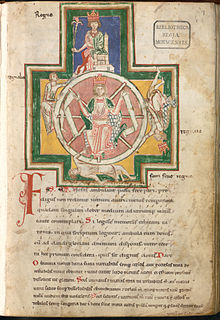Carmina Burana
From Wikipedia, the free encyclopedia
Carmina Burana (pronounced /ˈkɑrmɨnə bʊˈrɑːnə/), also known as the Burana Codex, is a manuscript collection found in 1803 in the Bavarian monastery of Benediktbeuern and now housed in the Bayerische Staatsbibliothek in Munich. The 119 leaves of the original collection contain 228 poems compiled by three different scribes.
Contents |
[edit] The manuscript
The Latin title Carmina Burana or Songs of Beuern was assigned by Johann Andreas Schmeller in 1847. Beuern (from Old High German bur = "small house") refers to the abbey of Benediktbeuern founded in 733 in the foothills of the Bavarian Alps about thirty miles south of Munich. Subsequent research has shown that the manuscript did not originate there; Seckau Abbey is regarded as a likely earlier location.
The pieces are almost entirely in Ecclesiastical Latin meter; a few in a dialect of Middle High German, and some with traces of Old French. Many are macaronic, a mixture of Latin and German or French vernacular. They were written by students and clergy about 1230, when the Latin idiom was the lingua franca across Italy and western Europe for travelling scholars, universities and theologians. Most of the poems and songs appear to be the work of Goliards, clergy (mostly students) who sent up and satirized the Church. The collection preserves the works of a number of poets, including Peter of Blois, Walter of Châtillon and the anonymous one, referred to as the Archpoet.
[edit] Sections
The collection is divided into six sections:
- Carmina ecclesiastica (songs on religious themes)
- Carmina moralia et satirica (moral/satirical songs)
- Carmina amatoria (love songs)
- Carmina potoria (drinking songs - also includes gambling songs and parodies)
- Ludi (religious plays)
- Supplementum (versions of some of the earlier songs with textual variations)
The first section, thought to be of religious songs, is now lost and there is no record of the missing poems. Therefore, it is impossible to trace the manuscript's existence before its mutilation, since manuscripts were usually catalogued by their opening line. The final section was not originally part of the manuscript and is a scholarly reconstruction of some of the poems where differences and emendations have been found buried underneath other texts.
Many of the religious songs and several of the love songs and drinking songs are accompanied by neumes that suggest melodies. Some of the poems have also had corresponding melodies discovered in later manuscript sources.
A typical example of one of the love songs is 13 (85), which highlights the melodious aspect of medieval Latin lyric:
|
|
[edit] Musical settings of these texts
Between 1935 and 1936, German composer Carl Orff set 24 of the poems to new music, also called Carmina Burana. The most famous movement is "Fortuna, Imperatrix Mundi (O Fortuna)" (Fortuna meaning Fortune in Latin, as well as a Roman goddess). Orff's composition has been performed by countless ensembles.
Other musical settings include:
- Several German bands (including Corvus Corax, Estampie, Qntal, Finisterra, Helium Vola, and In Extremo) regularly use poems from the manuscript as lyrics.
- Swedish symphonic metal band Therion played O Fortuna on album Deggial.
- Trans-Siberian Orchestra has also done a rendition of O Fortuna, seen in many of their live shows, and is expected to be released in 2009, on a non-Christmas album entitled Night Castle
- German band Corvus Corax recorded Cantus Buranus, a full-length opera set to the original Carmina Burana manuscript in 2005, and released Cantus Buranus Werk II in 2008.
- The video game Final Fantasy VII's most famous musical piece, One-Winged Angel (composed by Nobuo Uematsu), utilizes lyrics from Carmina Burana (specifically from O Fortuna, Estuans interius, Veni, veni, venias and Ave formosissima).
- Pieces by German/Norwegian doom/gothic metal band Theatre of Tragedy, such as Amor Volat Undique and Circa Mea Pectora in the song Venus (album Aégis)
- Synth/Medieval, French band Era recorded a Mix called The Mass featuring pieces of O Fortuna from the original Carmina Burana.
- Pieces by the Norwegian gothic metal musical group Tristania (Wormwood from album World Of Glass 2001)
- American hardcore band Botch covers O Fortuna on the EP The Unifying Themes of Sex, Death and Religion.
- Pieces by the Swedish medieval inspired band Rävspel och Kråksång translated into Swedish.
- Ray Manzarek (of The Doors) recorded an edited version of this piece with Philip Glass. This was released in 1983.
- Composer John Paul used a portion of the lyrics of Fas et nefas ambulant in the musical score of the video game Gauntlet Legends. [1]
- Philip Pickett and the New London Consort issued a 4-volume set of Carmina Burana settings using medieval instrumentation and performance techniques.
[edit] See also
[edit] Footnotes
[edit] References
- Ensemble Unicorn/Ensemble Oni Wytars (under the direction of Michael Posch and Marco Ambrosini, 1997)
[edit] External links
| Wikiquote has a collection of quotations related to: Carmina Burana |
| Wikimedia Commons has media related to: Carmina Burana manuscript |




